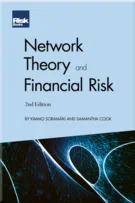UCL Research Shows that SMA Reforms Introduces Capital Instability and Discourages Risk Management
Ariane Chapelle, Gareth W Peters, Pavel V Shevchenko and Bertrand Hassani
Introduction
Operational Risk in Four Letters
An Invisible Framework
Small is Beautiful in OpRisk Management
The Business Value of ORM
How to Minimise ‘People Risk’
The Missing Piece
Risk Appetite and Framework
From Russian Roulette to Overcautious Decision-making
The Importance of Preventive KRIs
How to Build Preventive Key Risk Indicators
Unlocking KRIs
Six Steps for Preventive KRIs
Have Your Cake and Eat It
Conduct, Not ‘Conduct Risk’
How to Manage Incentives
Is Reputation Risk Overstated?
What Regulators Want
Conduct & Culture
OpRisk Takes Forward Steps at OpRisk Europe 2014
Modern Scenario Analysis
The Rogue’s Path
Rogue Trading No Training: The Connections
What Brexit Teaches OpRisk
OpRisk Survey Shows the Insidious Effects of Political Risk
Discarding the AMA Could Become a Source of OpRisk
UCL Research Shows that SMA Reforms Introduces Capital Instability and Discourages Risk Management
Memo to Bank CEOs: Treat OpRisk with More Respect
Don’t Let the SMA Kill OpRisk Modelling
As members of the University College London Faculty and risk specialist, we felt that it was our duty to produce an official response to the Basel Committee’s consultation of the proposed reform of operational risk capital calculation into a “Standardized Measurement Approach” (SMA). This response was published in September 2016 by the Journal of Operational Risk under the title “Should the Advanced Measurement Approach be replaced by the Standardized Measurement Approach for operational risk?” and has been awarded “Paper of the Year” by Risk in 2017. This chapter is a short version of our position. We demonstrate that SMA fails to achieve the claimed objective of robust capital estimation, risk sensitivity, and prudential objective for the financial industry.
SMA INTRODUCES CAPITAL INSTABILITY
The formula proposed by the Committee as the future regulation for the capitalization of operational has significant weaknesses. One of them is significant capital instability. Our analysis shows that, a given institution can experience the situation in which its capital can more than double from one year to the next, without any changes to the parameters, the model or the BI structure
Copyright Infopro Digital Limited. All rights reserved.
As outlined in our terms and conditions, https://www.infopro-digital.com/terms-and-conditions/subscriptions/ (point 2.4), printing is limited to a single copy.
If you would like to purchase additional rights please email info@risk.net
Copyright Infopro Digital Limited. All rights reserved.
You may share this content using our article tools. As outlined in our terms and conditions, https://www.infopro-digital.com/terms-and-conditions/subscriptions/ (clause 2.4), an Authorised User may only make one copy of the materials for their own personal use. You must also comply with the restrictions in clause 2.5.
If you would like to purchase additional rights please email info@risk.net









